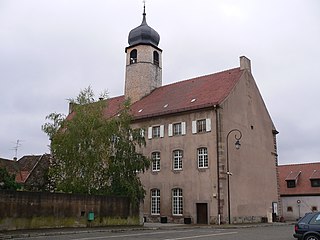This page is based on this
Wikipedia article Text is available under the
CC BY-SA 4.0 license; additional terms may apply.
Images, videos and audio are available under their respective licenses.

Kaiser Wilhelm der Grosse was a German transatlantic ocean liner named after Wilhelm I, German Emperor, the first monarch of the (second) German Empire.

Wilhelm II was the last German Emperor (Kaiser) and King of Prussia, reigning from 15 June 1888 until his abdication on 9 November 1918 shortly before Germany's defeat in World War I. He was the eldest grandchild of Queen Victoria of the United Kingdom and related to many monarchs and princes of Europe, most notably his first cousin King George V of the United Kingdom and Emperor Nicholas II of Russia, whose wife, Alexandra, was Wilhelm and George's first cousin.

The Kaiser Wilhelm Society for the Advancement of Science was a German scientific institution established in the German Empire in 1911. Under the Third Reich it was involved in Nazi scientific operations, and after World War II concluded, its functions were taken over by the Max Planck Society. The Kaiser Wilhelm Society was an umbrella organisation for many institutes, testing stations, and research units created under its authority.
The Grand Cross of the Iron Cross was a decoration intended for victorious generals of the Prussian Army and its allies. It was the highest class of the Iron Cross. Along with the Iron Cross 1st and 2nd Class, the Grand Cross was founded on 10 March 1813, during the Napoleonic Wars. It was renewed in 1870 for the Franco-Prussian War and again in 1914 for World War I. In 1939, when Adolf Hitler renewed the Iron Cross as a German decoration, he also renewed the Grand Cross.
Kaiser is an imperial title meaning "emperor", which is mainly used in German language; in late antiquity, the German Kaiser emerged from the Latin caesar.

The second SS Kaiser Wilhelm II, named for the German Emperor, was a 19,361 gross ton passenger ship built at Stettin, Germany. The ship was completed in the spring of 1903. The ship was seized by the U.S. Government during World War I, and subsequently served as a transport ship under the name USS Agamemnon. A famous photograph taken by Alfred Stieglitz called The Steerage, as well as descriptions of the conditions of travel in the lowest class, have conflicted with her otherwise glitzy reputation as a high class, high speed trans-Atlantic liner.

Mutzig is a commune located at the entrance of the Bruche river valley, in the Bas-Rhin department in Grand Est, in north-eastern France. The commune of Mutzig is on the Route des Vins d'Alsace.

Lieutenant General Kuno Augustus Friedrich Karl Detlev Graf von Moltke, adjutant to Kaiser Wilhelm II and military commander of Berlin, was a principal in the homosexual scandal known as the Harden-Eulenburg Affair (1907) that rocked the Kaiser's entourage. Moltke was forced to leave the military service.
John C. G. Röhl is a British historian.

Kaiser Friedrich III-class battleships were a class of pre–World War I, pre-dreadnought battleships of the German Kaiserliche Marine. The class was made up of five ships, all of which were named for German emperors. The Kaiser Friedrich III class saw the introduction of the traditional armament layout for German battleships—four large-caliber guns, but of comparatively smaller caliber compared to contemporary battleships, in two gun turrets—prior to the advent of the dreadnought type of battleship in the early 1900s. They also standardized the use of three screws for battleships.

SMS Kaiser Wilhelm II was the second ship of the Kaiser Friedrich III class of pre-dreadnought battleships. She was built at the Imperial Dockyard in Wilhelmshaven and launched on 14 September 1897. The ship was commissioned into the fleet as its flagship on 13 February 1900. Kaiser Wilhelm II was armed with a main battery of four 24-centimeter (9.45 in) guns in two twin turrets. She was powered by triple expansion engines that delivered a top speed of 17.5 knots.

SMS Kaiser Wilhelm der Grosse was a German pre-dreadnought battleship of the Kaiser Friedrich III class, built around the turn of the 20th century. The ship was one of the first battleships built by the German Imperial Navy as part of a program of naval expansion under Kaiser Wilhelm II. Kaiser Wilhelm der Grosse was built in Kiel at the Germaniawerft shipyard. She was laid down in January 1898, launched in June 1899, and completed in May 1901. The ship was armed with a main battery of four 24-centimeter (9.4 in) guns in two twin gun turrets.

SMS Kaiser was the lead ship of the Kaiser-class ironclads; SMS Deutschland was her sister ship. Named for the title "Kaiser", held by the leader of the then newly created German Empire, the ship was laid down in the Samuda Brothers shipyard in London in 1871. The ship was launched in March 1874 and commissioned into the German fleet in February 1875. Kaiser mounted a main battery of eight 26 cm (10 in) guns in a central battery amidships.

A large number of monuments were erected in Germany in honour of Emperor William I. As early as 1867 the Berlin sculptor, Friedrich Drake, had created the first equestrian statue, that portrayed William I as the King of Prussia. To date the Prussian Monument Institute has recorded:
Emperor towers or Kaiser towers are monuments that were built up to 1918 in honour of the German emperors William I, Frederick III and Wilhelm II in the German Empire or for Emperor Franz Josef in Austria-Hungary.
Events in the year 1918 in Germany.










